Greetings All,
My second week of school had largely the same schedule as the first week. One of the highlights, the Tuscan cooking class, took place on Monday evening. 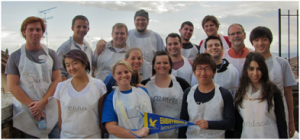
Our entire study abroad group. Picture from Bonnie Pratt. The above picture contains all of the students in our study abroad group including our student aid, Joey, and Dr. Pratt. Not pictured is Professor Pratt’s wife, Bonnie. Dante Alighieri, the Italian institution that we attend for language and culture classes, had us cook because one of the distinguishing features of Siena is the Tuscan cooking style.
We prepared a total of four courses that were crafted from a variety of different ingredients. In Italian, the four dishes we made were sformatino di zucchini, pappardelle con melanzane e funghi, rotolini di tacchino con champignon e limone, and tiramisu alle fragole, which translate roughly to zucchini quiche, pappardelle with eggplant and mushrooms, turkey rolls with mushrooms and lemon, and strawberry tiramisu. Pappardelle is essentially a broad fettuccine noodle. After we finished cooking, we were able to eat our meal.
 Here are some students getting ready to eat. Picture courtesy of Bonnie Pratt. In the above picture, the blond woman is Dr. Pratt’s wife, Bonnie. She’s really nice and a favorite of the students. She enjoyed our meal. The noodles we made were by far the best noodles I have had while in Italy so far. Our meal lasted until around 10 PM at which we returned to our residence and went to bed in preparation for Luca’s class the next day.
Here are some students getting ready to eat. Picture courtesy of Bonnie Pratt. In the above picture, the blond woman is Dr. Pratt’s wife, Bonnie. She’s really nice and a favorite of the students. She enjoyed our meal. The noodles we made were by far the best noodles I have had while in Italy so far. Our meal lasted until around 10 PM at which we returned to our residence and went to bed in preparation for Luca’s class the next day.
My favorite lesson that Luca taught was about the contrade of Siena and the Palio. The contrade are one of the most distinctive features of Siena and originate from the Middle Ages. In the past, Siena had up to 59 contrade, or districts. Currently, however, the city has a total of seventeen contrade. Each ward has its own museum, fountain, church, colors, and symbol. Some even have allies and adversaries. 
The colors and symbol of the Woods contrada. Our residence is located in the Dragon contrada, but we pass through the Goose and Woods contrade on our way to Dante Alighieri, which is located in the Tortoise contrada. The Sienese who live in each area of the city feel very unified, patriotic, and proud of their contrada. For example, one day while I was at the post office, a teenage boy had a tattoo on his leg depicting the flag of his contrada, the Tower. The symbol of the Tower is an elephant with an obelisk on its back.
During our second week in Siena, the Dragon contrada was celebrating one of its holidays. The street was decorated with ornate lights that were painted the colors of the contrada: magenta, green, and gold. Children, teens, and adults alike walked around with their neighborhood’s flag tied around their neck. On the weekend, there was a giant feast that included the entire population of the ward on one of the streets near our residence.
These customs have been practiced for centuries. In the past, the neighborhoods were charged with protecting their fountain, which was the ward’s water supply, and to give men to serve in Siena’s army that protected the city. Today, they serve to enhance and enrich citizens’ cultural identity, allowing them to both remember the past and live in the present. For example, each contrade participates in the Palio, which dates as far back as medieval times.
The Palio horse race is held twice each year on July 2 and August 16. Siena puts quite a bit of money into each race in order to pay for the horses, hire jockeys, purchase decorations, etc. In addition, jockeys are given undisclosed amounts of money to bribe other riders in order to gain some sort of advantage during the Palio. Each race consists of ten horses that are ridden bareback by jockeys dressed in their contrada’s colors.
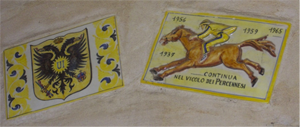 The stable of the Eagle contrada. The racetrack goes around the Piazza del Campo, the Siena’s city center. The race circles the Campo three times and typically lasts less than two minutes. Sometimes the goal of the jockeys is to keep the rival contrada from winning and sometimes jockeys are thrown from their horse. Luckily, the winner of the Palio is the first horse that crosses the finish line, not the rider. The loser of the race is considered to be the horse that came in second, not last. This is because the second place horse came so close to winning but failed to do so. We had multiple classes that taught us about the contrade and the Palio. Another part of our classes consisted of visiting different cities in Italy.
The stable of the Eagle contrada. The racetrack goes around the Piazza del Campo, the Siena’s city center. The race circles the Campo three times and typically lasts less than two minutes. Sometimes the goal of the jockeys is to keep the rival contrada from winning and sometimes jockeys are thrown from their horse. Luckily, the winner of the Palio is the first horse that crosses the finish line, not the rider. The loser of the race is considered to be the horse that came in second, not last. This is because the second place horse came so close to winning but failed to do so. We had multiple classes that taught us about the contrade and the Palio. Another part of our classes consisted of visiting different cities in Italy.
During the second week of our studies, we visited two cities, San Gimignano and Venice. San Gimignano, a UNESCO World Heritage Site, is located in the providence of Siena, Tuscany. The walled medieval hill town is famous for its architecture, specifically its towers.
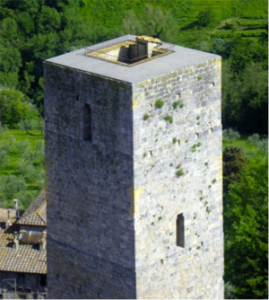 One of San Gimignano’s remaining towers. At one point in time, the city had as many as seventy two towers. The largest of these were around fifty meters tall. It is thought that affluent families would have towers built to show their wealth and supremacy. Currently, however, there are only fourteen towers still standing. The others were taken down due to wear, rebuilding, and wars. In the past, whenever a city was captured, the conquerors would knock down the town’s tower to symbolize the loss of power. During our trip to the city, we took the time to climb up San Gimignano’s tallest tower in order to view the beautiful Tuscan landscape. We could see the rolling hills, neighboring towns, vineyards, and rows upon rows of olive trees.
One of San Gimignano’s remaining towers. At one point in time, the city had as many as seventy two towers. The largest of these were around fifty meters tall. It is thought that affluent families would have towers built to show their wealth and supremacy. Currently, however, there are only fourteen towers still standing. The others were taken down due to wear, rebuilding, and wars. In the past, whenever a city was captured, the conquerors would knock down the town’s tower to symbolize the loss of power. During our trip to the city, we took the time to climb up San Gimignano’s tallest tower in order to view the beautiful Tuscan landscape. We could see the rolling hills, neighboring towns, vineyards, and rows upon rows of olive trees.
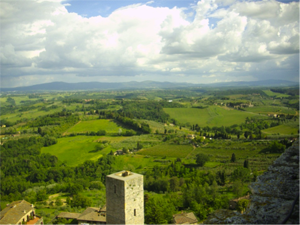 A view of Tuscany from the tallest tower of San Gimignano. Later that same week, we visited Venice. The city is built on top of 118 small islands that are connected by bridges and canals. The city, and the lagoon it rests in, is considered a World Heritage Site.
A view of Tuscany from the tallest tower of San Gimignano. Later that same week, we visited Venice. The city is built on top of 118 small islands that are connected by bridges and canals. The city, and the lagoon it rests in, is considered a World Heritage Site.
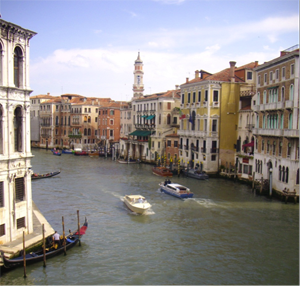 The Grand Canal, one of the main waterways of the city. This picture was taken from the Scalzi Bridge. During the Middle Ages and the Renaissance, Venice was a major maritime power and an important center of commerce due to the city’s location directly on the water. Furthermore, the metropolis was also the origin of many important artistic movements and styles, such as the Renaissance and the Venetian School. Presently, this town is very famous for its Venetian glass and the Carnival of Venice, which is when people wear intricate and beautiful masks.
The Grand Canal, one of the main waterways of the city. This picture was taken from the Scalzi Bridge. During the Middle Ages and the Renaissance, Venice was a major maritime power and an important center of commerce due to the city’s location directly on the water. Furthermore, the metropolis was also the origin of many important artistic movements and styles, such as the Renaissance and the Venetian School. Presently, this town is very famous for its Venetian glass and the Carnival of Venice, which is when people wear intricate and beautiful masks.
During our first day in the city, we visited the Doge’s Palace. The Doge is the title for the chief magistrate and supreme leader of the Republic of Venice. They are elected for life by the aristocracy. The palace was built in the Venetian Gothic style. Originally, it was used to house the Doge, but now the building serves as a landmark and museum.
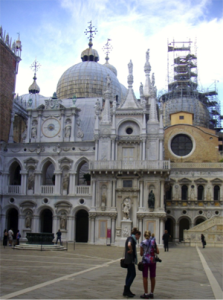 This is a view from the inner courtyard of the Doge’s Palace. My favorite exhibit in the museum was about medieval warfare. The display had many artifacts and was quite expansive. There were full suits of armor for people and horses, swords, daggers, crossbows, guns, spears, and so much more. Since my father loves knights, I grew up adoring castles and watching films about the Middle Ages. I was very disappointed to find out that I was not allowed to take pictures of the collection. I must have spent up to two hours in the museum.
This is a view from the inner courtyard of the Doge’s Palace. My favorite exhibit in the museum was about medieval warfare. The display had many artifacts and was quite expansive. There were full suits of armor for people and horses, swords, daggers, crossbows, guns, spears, and so much more. Since my father loves knights, I grew up adoring castles and watching films about the Middle Ages. I was very disappointed to find out that I was not allowed to take pictures of the collection. I must have spent up to two hours in the museum.
After the Doge’s Palace, I had some free time with which I used to explore Venice. I saw both men and women in brightly colored carnival costumes wearing dresses with huge skirts and white painted masks. If people put euros into the baskets of the festival performers, they could take a picture with them.
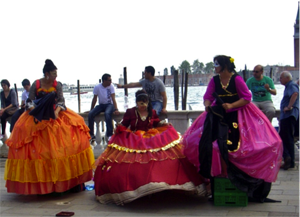 Three people putting on their Carnival of Venice costumes. When I was walking around Venice from island to island across the bridges, I noticed that some of the crossings had locks attached to them. These locks usually had two names written on them and the date of when the lock was placed on the bridge. Sometimes there were even inscriptions about love lasting forever, giving them the name “love locks”.
Three people putting on their Carnival of Venice costumes. When I was walking around Venice from island to island across the bridges, I noticed that some of the crossings had locks attached to them. These locks usually had two names written on them and the date of when the lock was placed on the bridge. Sometimes there were even inscriptions about love lasting forever, giving them the name “love locks”.
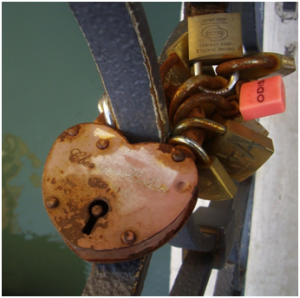 Some of the many love locks that I saw attached bridges. The idea behind the love locks is that two sweethearts engrave their names onto a padlock and attach it to a public fixture such as a bridge, gate, fence, etc. and throw away the key. Since the lock cannot ever be removed, this symbolizes their undying love for each other. While an appealing idea, these love locks are considered to be controversial. Some people do not like them because they build up over time and can affect the aesthetic quality of public places.
Some of the many love locks that I saw attached bridges. The idea behind the love locks is that two sweethearts engrave their names onto a padlock and attach it to a public fixture such as a bridge, gate, fence, etc. and throw away the key. Since the lock cannot ever be removed, this symbolizes their undying love for each other. While an appealing idea, these love locks are considered to be controversial. Some people do not like them because they build up over time and can affect the aesthetic quality of public places.
Thank you for reading this entry and I hope that you thoroughly enjoyed it as well as learned a little bit about Italy.


